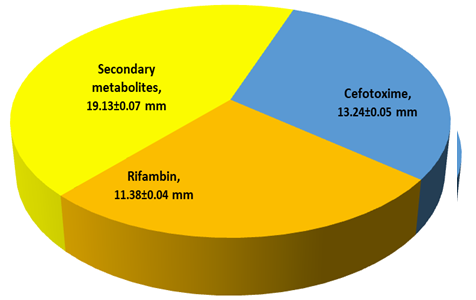Bioactive Natural Compounds of Zingiber officinale Using Gas Chromatography-Mass Spectrometry and Evaluation of Its Antibacterial Activity
Abstract
Full text article
References
Crichton, M., Marshall, S., Marx, W., McCarthy, A.L. and Isenring, E. (2019). Efficacy of ginger (Zingiber officinale) in ameliorating chemotherapy-induced nausea and vomiting and chemotherapy-related outcomes: A systematic review update and metaanalysis. Journal of The Academy of Nutrition and Dietetics, 119(12), 2055–2068.
Danwilai, K., Konmun, J., Sripanidkulchai, B.O. and Subongkot, S. (2017). Antioxidant activity of ginger extract as a daily supplement in cancer patients receiving adjuvant chemotherapy: A pilot study. Cancer Management Research, 9, 11–18.
El-Gayar, M.H., Aboromia, M.M.M., Ibrahim, N.A. and Abdel-Hafiz, M.H. (2019). Effects of ginger powder supplementation on glycemic status and lipid profile in newly diagnosed obese patients with type 2 diabetes mellitus. Obesity Medicine, 14, 100094.
El-Ghorab, A.H., Nauman, M., Anjum, F.M., Hussain, S. and Nadeem, M.A. (2010). Comparative study on chemical composition and antioxidant activity of ginger (Zingiber officinale) and cumin (Cuminum cyminum). Journal of Agricultural Food Chemistry, 58(14), 8231–8237.
Al-Yahya MA (1986). Phytochemical studies of the plants used in traditional medicine of Saudi Arabia. Fitoterapia 57(3):179-182.
Abdulelah HA, Abidin BA (2007). In vivo anti-malarial tests of Nigella sativa (black seed) Different extracts. Am. J. Pharm. Toxic. 2:46-50.
Aboul-Ela MA, El-Shaer NS, Ghanem NB (1996). Antimicrobial evaluation and chromatographic analysis of some essential and fixed oils. Pharmazie 51:993-4.
Abu-Jadayil S, Tukan SKH, Takruri HR (1999). Bioavailability of iron from four different local food plants in Jordan. Pl. Foods. Hum. Nutr. 54:285–294.
Ali A, Alkhawajah, Randhawa MA, Shaikh NA (2008). Oral and interaperitoneal LD50 of thymoquinone an active principal of Nigella sativa in mice and rats. J. Ayub Med. Coll. 20(2):25-27.
Ali BH, Blunden G (2003). Pharmacological and toxicological properties of Nigella sativa. Phytother Res. 17(4):299-305.
Al-Johar D, Shinwari N, Arif J, Al-Sanea N, Jabbar AA, El-Sayed R, Mashhour A, Billedo G, El-Doush I, Al-Saleh I (2008). Role of Nigella sativa and a number of its antioxidant constituents towards azoxymethane-inducedgenotoxic effects and colon cancer in rats. Phytother. Res. 22:1311-1323.
Al-Othman AM, Ahmad F, Al-Orf S, Al-Murshed SK, Arif Z (2006). Effect of dietary supplementation of Ellataria cardamomum and Nigella sativa on the toxicity of rancid corn oil in Rats. Int. J. Pharmacol. 2:60-65.
Ashraf R (2011). Plant (Garlic) Supplement with standard Antidiabetic agent provides better diabetic control in Type-II diabetes patients. Pak. J. Pharmaceut. Sci. 24(4):565-570.
Boskabady MH, Javan H, Sajady M, Rakhshandeh H (2007). The possible prophylactic effect of Nigella sativa seed extract in asthmatic patients. Fundam. Clin. Pharmacol. 21(5):559-566.
Chaudhry N, Tariq P (2008). In vitro antibacterial activities of Kalongi, Cumin and Poppy seed. Pak. J. Bot. 40(1):461-467.
Enomoto S, Asano R, Iwahori Y, Narui T, Okada Y, Singab AN, Okuyama T (2001). Hematological studies on black cumin oil from the seeds of Nigella sativa L. Biol. Pharm. Bull. 24:307–10.
Hameed IH, Hussein HJ, Kareem MA, Hamad NS (2015a). Identification of five newly described bioactive chemical compounds in methanolic extract of Mentha viridis by using gas chromatography-mass spectrometry (GC-MS). J. Pharmacogn. Phytother. 7 (7):107-125.
Hamza LF, Kamal SA, Hameed IH (2015). Determination of metabolites products by Penicillium expansum and evaluating antimicobial activity. J. Pharmacogn. Phytother. 7(9):194-220.
Hussein AO, Hameed IH, Jasim H, Kareem MA (2015). Determination of alkaloid compounds of Ricinus communis by using gas chromatography-mass spectroscopy (GC-MS). J. Med. Plants Res. 9(10):349-359.
Iqbal MS, Qureshi AS, Ghafoor A (2010). Evaluation of Nigella sativa L., for genetic variation and Ex-situ conservation. Pak. J. Bot. 42(4):2489-2495.
Jasim H, Hussein AO, Hameed IH, Kareem MA (2015). Characterization of alkaloid constitution and evaluation of antimicrobial activity of Solanum nigrum using gas chromatography mass spectrometry (GC-MS). J. Pharmacogn. Phytother. 7(4):56-72.
Kanter M (2008). Effects of Nigella sativa and its major constituent, thymoquinone onsciatic nerves in experimental diabetic neuropathy. Neurochem. Res. 33:87-96.
Mansour MA, Nagi MN, El-Khatib AS, Al-Bekairi AM (2002). Effects of thymoquinone on antioxidant enzyme activities, lipid peroxidation and DT-diaphorase in different tissues of mice: a possible mechanism of action. Cell. Biochem. Funct. 20:143–51.
Mohammed A, Imad H (2013). Autosomal STR: From locus information to next generation sequencing technology. Res. J. Biotechnol. 8(10):92-105.
Rader JI, Delmonte P, Trucksess MW (2007). Recent studies on selected botanical dietary supplement ingredients. Anal. Bioanal. Chem. 389:27-35.
Sethi G, Ahn K, Aggarwal B (2008). Targeting nuclear factor-kappa B activation Pathway by thymoquinone: Role in suppression of antiapoptotic gene products and enhancement of apoptosis. Mol. Cancer Res. 6:1059-1070.
Sharma NK, Ahirwar D, Jhade D, Gupta S (2009). Medicinal and pharmacological potential of Nigella sativa: A review. Ethnobot. Rev. 13:946-5
Authors

This work is licensed under a Creative Commons Attribution 4.0 International License.
